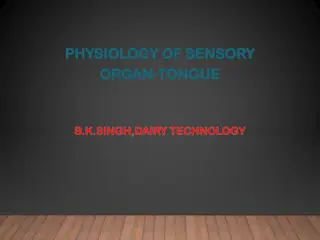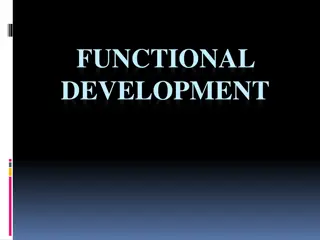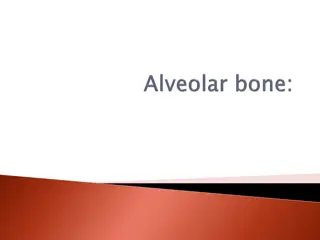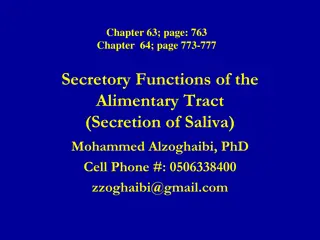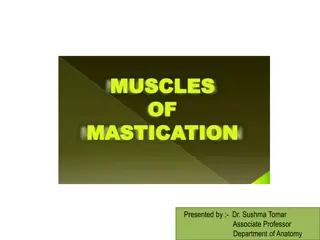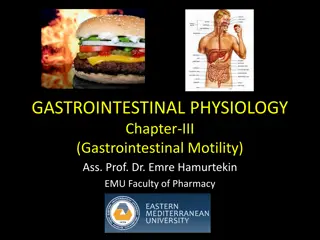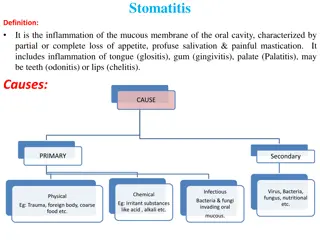Understanding Mastication in Digestive System
Mastication is the process of cutting and grinding food to prepare it for digestion. This stage increases the surface area of food for efficient enzyme breakdown. The significance of mastication includes breaking down food into smaller particles, mixing with saliva, and enhancing taste. The chewing
1 views • 25 slides
ENAMEL
Enamel, the hardest calcified tissue in the human body, forms a protective covering over the teeth, adapting them for mastication. Its thickness varies across different surfaces of the teeth, with maximum thickness found on cusps. The structure of enamel makes it brittle, especially when it loses su
2 views • 46 slides
Understanding the Physiology of the Sensory Organ - Tongue by B.K. Singh
Taste perception on the tongue is a vital sensory function involving sweet, sour, salty, and bitter sensations. The tongue, with its muscular movements and taste buds, plays a crucial role in mastication, swallowing, and food enjoyment. Different types of papillae on the tongue are responsible for t
4 views • 33 slides
Understanding Orofacial Development and Functions in Dentistry
Explore the intricate orofacial structures, including dental arches, naso-maxillary complex, mandible, and muscles of expression, mastication, and deglutition. Learn about the various functions performed by the orofacial complex, such as mastication, deglutition, respiration, and speech. Dive into t
1 views • 23 slides
Structure and Functions of the Alveolar Process in Jaw Anatomy
The alveolar process in the upper and lower jaw is responsible for housing the roots of teeth, supporting tooth eruption, providing attachment for facial muscles, and aiding in mastication. During fetal development, the alveolar process forms and separates tooth germs, leading to the differentiation
3 views • 26 slides
Understanding the Secretory Functions of the Alimentary Tract
This content delves into the secretory functions of the alimentary tract, focusing on the secretion of saliva and the role of mastication. It covers the anatomy of salivary glands, composition of saliva, control of secretion by the nervous system, and the functions of saliva in lubrication, protecti
1 views • 30 slides
Overview of Muscles of Mastication in Anatomy
This presentation by Dr. Sushma Tomar provides detailed information on the principal and accessory muscles of mastication, focusing on the Masseter and Temporalis muscles. It covers their origins, insertions, nerve supplies, actions, and applied aspects like trismus. The content is accompanied by im
0 views • 20 slides
Clinical Evaluation of Trigeminal Nerve Function
Sensory evaluation of trigeminal nerve function involves assessing exteroceptive sensations across its divisions, identifying sensory losses due to lesions, and distinguishing different types of lesions affecting sensation on the face. Motor evaluation focuses on the muscles of mastication to detect
0 views • 34 slides
Understanding Gastrointestinal Motility: Key Concepts and Mechanisms
Gastrointestinal motility involves various processes like peristalsis, segmentation, basic electrical activity, and the migrating motor complex. Peristalsis is the reflex response to gut wall stretching, while segmentation helps mix intestinal contents and digestive juices. Basic Electrical Rhythm (
0 views • 19 slides
Understanding Stomatitis: Causes, Symptoms, and Treatment Options
Stomatitis is the inflammation of the mucous membrane in the oral cavity, resulting in symptoms like loss of appetite, salivation, and painful mastication. It can be caused by various factors such as viruses, bacteria, fungi, and irritants. Treatment involves hygiene measures, medical interventions
0 views • 4 slides


